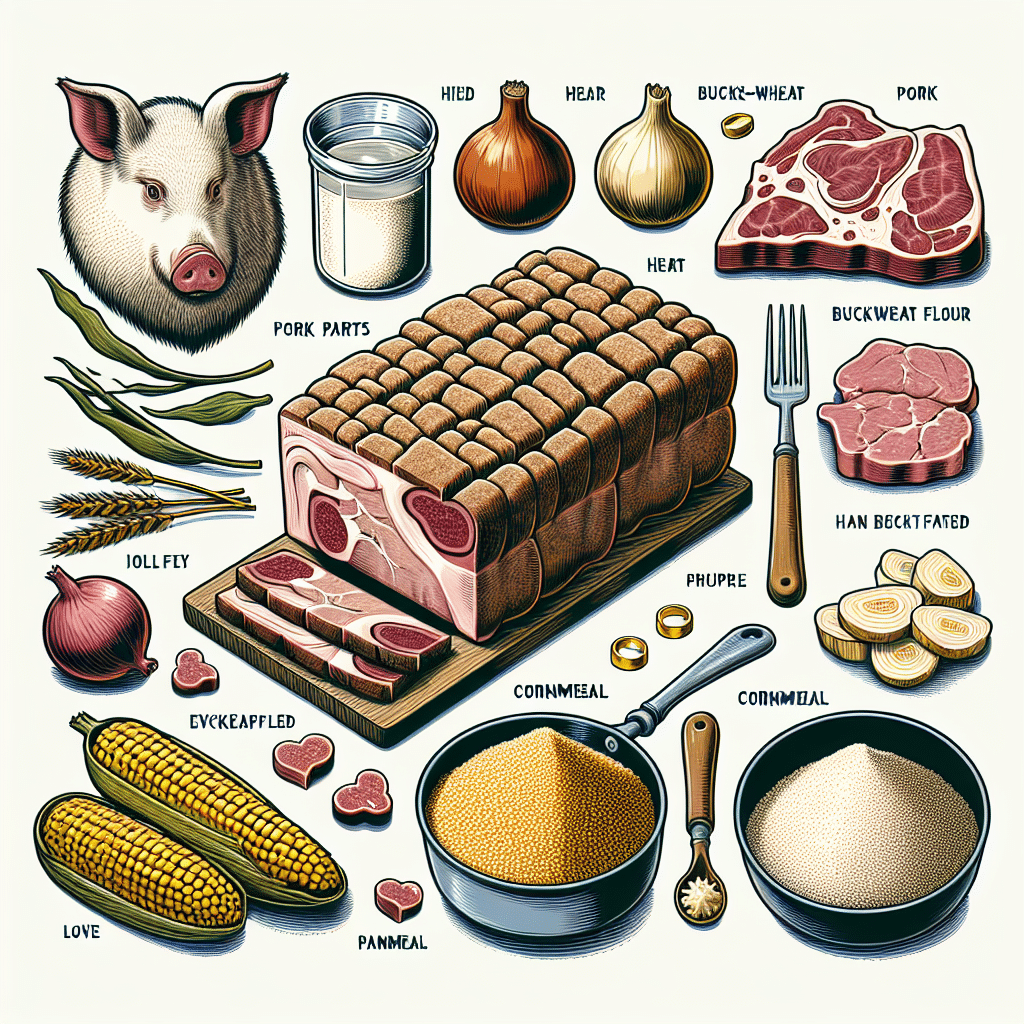Scrapple is a traditional dish originating from the Pennsylvania Dutch community, primarily made from pork scraps and trimmings mixed with cornmeal and spices. The preparation begins by simmering leftover cuts of pork, and often includes parts of the head, skin, and sometimes the liver, which are then finely chopped or ground. The mixture is combined with cornmeal, wheat flour, and various seasonings, creating a thick, loaf-like consistency. After cooking, scrapple is allowed to cool and set, forming a solid block that can be sliced and pan-fried until crispy. It is often served for breakfast, accompanied by eggs, or as a side dish, showcasing its hearty and flavorful nature. This dish exemplifies the resourcefulness of traditional cooking, effectively utilizing animal parts that might otherwise go to waste, making it a beloved comfort food in many regions.
1. The History of Scrapple
Scrapple’s origins can be traced back to German immigrants who settled in Pennsylvania during the 17th and 18th centuries. These settlers brought with them their culinary traditions, which emphasized the use of all parts of a pig, especially after slaughter. This frugality in cooking mirrored the practical lifestyle of these communities, where waste was minimized. The early versions of scrapple likely varied significantly based on individual family recipes, but the core ingredients have remained consistent over centuries. As scrapple gained popularity, it evolved to reflect regional tastes, leading to the creation of various adaptations seen across the United States today.
2. Ingredients of Scrapple
The primary components of scrapple include:
- Pork: The key ingredient, typically comprising leftover scraps and trimmings from butchering. Popular cuts include the head, heart, and sometimes liver. The use of these parts is essential for achieving the unique flavor and texture of the dish.
- Cornmeal: This ingredient serves as a binding agent, absorbing the moisture from the meat mixture and giving scrapple its distinctive grainy texture. Some recipes may also utilize flour in addition to cornmeal.
- Spices: A range of spices adds depth and flavor. Common seasonings include sage, pepper, and salt, but variations exist depending on local culinary traditions.
3. Preparation Process
Preparation of scrapple involves several steps:
- Cooking the Meat: The pork scraps are simmered in water or broth for several hours until tender. This process also extracts flavors into the liquid, which may be used in the final mixture.
- Shredding: Once cool, the pork is finely chopped or ground until it reaches a manageable consistency.
- Mixing Ingredients: The ground meat is combined with cornmeal, flour, spices, and the reserved cooking liquid. The mixture is stirred until it forms a thick paste.
- Setting: The mixture is poured into loaf pans and left to cool, allowing it to set into a firm block.
- Slicing and Cooking: Once set, the scrapple can be sliced to desired thickness. It is often pan-fried until the exterior is crispy and golden brown.
4. Variations of Scrapple
While traditional scrapple recipes contain pork, variations exist, particularly in regions where specific local ingredients are preferred. Some common adaptations may include:
- Beef or Turkey Scrapple: For those avoiding pork, alternative meats can be used, though the flavor profile will differ significantly.
- Vegetarian Options: Some contemporary chefs are experimenting with plant-based versions, using ingredients like lentils or mushrooms to replicate the texture.
- Regional Spices: Local flavors can lead to diverse seasoning blends focusing on regional herbs, such as thyme or garlic.
5. Nutritional Value
Scrapple is considered a hearty food, rich in protein due to its meat content. The accompanying cornmeal contributes carbohydrates and dietary fiber. However, it’s essential to consume scrapple in moderation, as it can be high in fat and sodium, depending on the recipe. For a nutrition breakdown:
- Protein: Provides essential amino acids necessary for muscle repair and growth.
- Carbohydrates: Offers energy, particularly from the cornmeal.
- Vitamins and Minerals: While scrapple may not be a significant source of vitamins, it can provide some B vitamins, iron, and zinc.
6. Cultural Significance
Scrapple holds cultural significance in many communities, especially in Pennsylvania and the mid-Atlantic states. It symbolizes resourcefulness in cooking and reflects the agricultural heritage of the regions where it is popular. Scrapple has also made its way into the culinary scene, appearing in restaurants and local diners as a breakfast staple or unique side dish. Its embrace within regional festivals, such as the annual Dutch Country Food Festival, invites food enthusiasts to explore scrapple beyond its humble beginnings.
7. Serving Suggestions
Scrapple is traditionally served for breakfast, and there are many ways to enjoy it:
- Classic Breakfast: Serve with eggs cooked to preference and toast or hotcakes.
- With Condiments: Some opt for mustard or maple syrup, which contrasts nicely with its savory flavors.
- In Sandwiches: Slices of fried scrapple can be added in a sandwich with cheese and pickles for a hearty lunch.
8. FAQs About Scrapple
What does scrapple taste like?
Scrapple has a unique, savory flavor profile, often described as hearty and rich, with a slightly crunchy exterior when pan-fried. The spices used can vary the taste significantly, contributing to a fragrant aroma and savory notes.
Is scrapple a healthy food option?
While scrapple can provide protein and carbs, it is also typically high in fat and sodium. It’s best consumed in moderation as part of a varied diet.
Can I freeze scrapple?
Yes, scrapple can be frozen. Sliced portions can be wrapped tightly in plastic wrap or aluminum foil and then stored in an airtight container or freezer bag. It can last for several months in the freezer.
How long does scrapple last in the refrigerator?
Properly stored scrapple can last about 1 week in the refrigerator. Always ensure that it is kept in an airtight container to maintain freshness.
Are there any gluten-free options for scrapple?
While traditional scrapple contains wheat flour, some recipes can be adapted using cornmeal exclusively or gluten-free flour alternatives.
Conclusion
Scrapple is a distinctive dish rooted in cultural traditions, making use of all parts of the animal to create a flavorful and hearty food. Through its simple yet rich ingredients and various adaptations, scrapple continues to delight palates across the United States. Whether enjoyed as part of a hearty breakfast or incorporated into modern culinary creations, its enduring presence reflects the historical significance and resourcefulness of traditional cooking practices.



